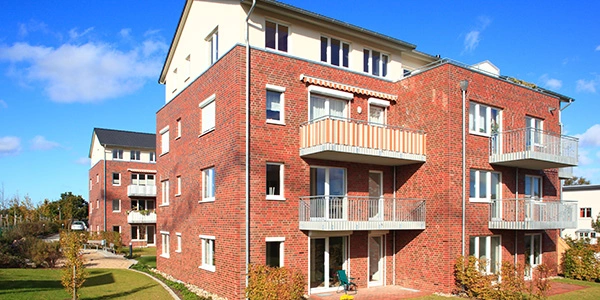What is Block of Flats Insurance?
Block of flats insurance is a type of insurance policy designed to cover the risks associated with owning and managing a block of flats or apartment building. Building insurance provides coverage for blocks of flats and apartments, ensuring that property owners are protected against various risks.
This type of insurance is typically purchased by the freeholder, landlord, or managing agent of the building, and it provides coverage for a wide range of risks that may arise, including:
- Property damage: This covers damage to the building and its contents caused by events such as fire, flood, storm, or theft.
- Liability: This covers legal liabilities arising from injuries or property damage suffered by third parties on the property.
- Loss of rent: This covers the loss of rental income if the property becomes uninhabitable due to an insured event.
- Terrorism: This covers damage to the property caused by acts of terrorism.
- Directors and officers liability: This covers legal liabilities arising from the actions of the block management company or its directors and officers.
While leaseholders might not need to arrange buildings insurance themselves, it’s important to verify the terms of their lease and consider their individual coverage needs. Typically, the freeholder or residents’ association handles this insurance.
A single insurance policy covering all the flats within a block can simplify the management of claims related to communal property aspects.
Understanding the policy wording and available coverages of a flats insurance policy is crucial for adequate protection.
Benefits of Flats Insurance Cover
Flats insurance cover provides numerous benefits to property owners, ensuring they are well-protected against various risks. Here are some key advantages:
- Financial Protection: Flats insurance cover safeguards property owners from significant financial losses due to damage to the building or its contents. Whether it’s a fire, flood, or theft, having the right insurance cover can help mitigate the financial impact.
- Peace of Mind: Knowing that your property is protected against unexpected events brings peace of mind. Flats insurance cover allows property owners to focus on managing their properties without constantly worrying about potential risks.
- Compliance with Lease Agreements: Many lease agreements require property owners to have adequate flats insurance cover. By securing the right insurance, property owners can ensure they comply with these contractual obligations, avoiding potential legal issues.
- Protection of Assets: Flats insurance cover helps protect the property owner’s assets, including the building and its contents. This protection is crucial in maintaining the property’s value and ensuring it remains a viable investment.
- Liability Protection: Flats insurance cover often includes liability protection, which can shield property owners from legal claims made by tenants or other third parties. This coverage is essential in managing the risks associated with property ownership.
How our process works
We’ve worked hard to refine our process and keep it as quick, easy and simple as possible for our customers.
Types of Flats Insurance Policies
There are several types of flats insurance policies available, each designed to address specific needs and risks. Understanding these options can help property owners choose the most suitable insurance cover for their properties:
- Buildings Insurance: This policy covers the physical structure of the building, including the walls, roof, and foundations. It protects against damage from events such as fire, flood, and storm, ensuring the building remains structurally sound.
- Contents Insurance: This policy covers the contents within the building, such as furniture, fixtures, and fittings. It provides financial protection against damage or loss due to theft, fire, or other insured events.
- Landlord Insurance: Designed for landlords who rent out their properties, this policy provides comprehensive cover for the building, contents, and liability. It ensures landlords are protected against various risks, including tenant damage and loss of rental income.
- Block Insurance: Specifically tailored for blocks of flats, this policy offers extensive cover for the building, contents, and liability. It is ideal for property owners or management companies responsible for multiple units within a single building.
- Directors and Officers Insurance: This policy provides cover for directors and officers of residential management companies and right-to-manage companies. It protects against legal liabilities arising from their actions, ensuring they can perform their duties without undue risk.
Is Block Of Flats Insurance A Legal Requirement?
Block of flats insurance is often a requirement of mortgage lenders and a condition of the leasehold agreement for the block of flats. This means that if you own a block of flats, you may be contractually obligated to have this type of insurance in place. Typically, the freeholder is responsible for arranging buildings insurance and charges leaseholders through service fees. However, leaseholders can form a Right to Manage company, allowing them the option to arrange insurance for the building themselves.
A residents association can play a crucial role in organizing blocks of flats insurance and managing shared responsibilities. This includes ensuring that appropriate insurance coverage is in place to protect against financial losses that may arise from mistakes in managing the association.
What Insurance Cover Is Needed For Flats?
The insurance coverage needed for flats may depend on a few different factors, including the location of the flats, the size of the building, the number of units, and the specific risks that the property is exposed to. However, in general, the following types of insurance cover are typically recommended for flats.
Who Pays For Insurance On A Block Of Flats?
It is the building owners responsibility to ensure the that block is insured. The policy though is likely to be arranged and administered by a managing agent who will divide the cost of the policy onto the individuals who rent or buy the separate flats. The individual amount will be charged via the service charged usually charged quarterly.
How the insurance is divided up between tenants can also vary. For example, some leasehold agreements may require the leaseholders to contribute a fixed percentage of the total insurance cost, while others may allocate the cost based on the floor area of each flat.
It is critically vital that the managing agent or owner ensures that the entire apartment block has appropriate insurance that will not only protect the landlord, but also the leaseholders and tenants.
Buildings Cover For A Block Of Flats
Building cover for flats typically includes protection for the physical structure of the building and its permanent fixtures and fittings. When considering flats building insurance, it is essential to provide guidance and answers to common questions about insurance policies specifically designed for leasehold flats and apartments.
The specific cover provided by a building cover policy can vary depending on the insurer and the policy terms. It’s therefore recommended to speak with a professional to determine the right level of coverage for your specific needs. It’s also important to regularly review and update your insurance policy to ensure that it remains appropriate and relevant to your changing circumstances.
Does Block of Flats Insurance Include Loss Of Rental Cover?
Block of flats insurance can include loss of rental cover which provides coverage for loss of rental income if the flats become uninhabitable due to an insured event, such as a fire, flood, or storm damage. This type of cover is particularly important for landlords who rely on rental income to cover the costs associated with owning and maintaining the block.
Loss of rental cover is designed to mitigate the financial impact of any loss of rental income by providing compensation for the lost rent for a set period of time. The specific amount and duration of this cover can vary depending on the insurer and the terms of the policy but it typically provides enough for a period of several months to a year. Severity of damage or reason for loss of rental income will also have an impact.
Loss of rental income is typically an additional extra and not something that comes as standard. When you compare insurance quotes for your block of flats, this is an addon you should consider including.
Does Block of Flats Insurance Cover Tenant Damage?
Block of flats insurance can provide coverage for tenant damage, but it depends on the specific policy terms and conditions.
Some block of flats insurance policies may include coverage for accidental damage caused by tenants, while others may exclude this type of damage or provide it as an optional extra.
It’s important to carefully review the policy terms and conditions to understand what is and is not covered by the insurance policy. If tenant damage is not covered by the insurance policy, it may be necessary to consider additional coverage options, such as landlord insurance or rent guarantee insurance.
Landlord insurance typically provides coverage for damage caused by tenants, including malicious damage and accidental damage, as well as protection against legal expenses and loss of rental income. Rent guarantee insurance provides coverage for the loss of rental income due to a tenant defaulting on rent payments.
You can speak to a block of flats insurance broker to discuss your options and be sure that the policy you choose covers everything you need.
Claims Process for Block of Flats Insurance
Navigating the claims process for block of flats insurance can be straightforward if you understand the typical steps involved. Here’s a general outline of what to expect:
- Notification: The first step is to notify your insurance company of the claim as soon as possible. Provide detailed information about the incident and the extent of the damage or loss.
- Assessment: The insurance company will assess the claim, often sending an adjuster to inspect the property and determine the extent of the damage or loss. This assessment helps the insurer understand the situation and estimate the cost of repairs or replacements.
- Validation: The insurance company will validate the claim by reviewing the policy terms and conditions to ensure the damage or loss is covered. They may request additional documentation or evidence to support the claim.
- Settlement: Once the claim is validated, the insurance company will settle the claim by providing payment to the property owner or manager. The settlement amount will depend on the policy terms and the extent of the damage or loss.
- Rebuilding or Repair: The final step involves using the settlement payment to rebuild or repair the damaged property. Property owners or managers should work with reputable contractors to ensure the repairs are completed to a high standard.
It’s essential to review your policy documents and contact your insurance company for specific guidance on the claims process. Each insurer may have slightly different procedures, so understanding your policy’s requirements can help streamline the process and ensure a successful claim.
Related News
Ways to Save Money on Landlord Insurance
Get a Quick Landlord Insurance Quote Many people look to invest in property as a way of investment or income. This can vary from single residential landlord properties through to commercial



